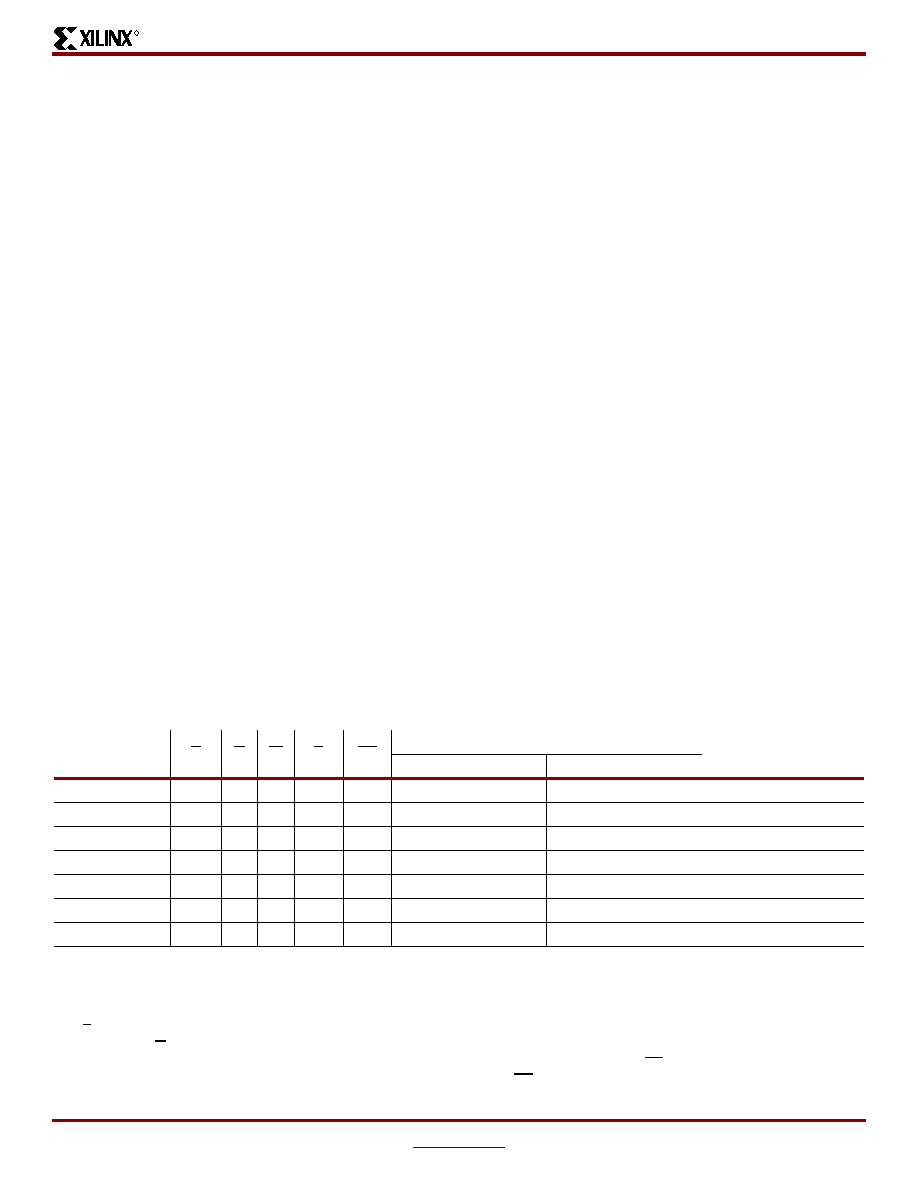- 您現(xiàn)在的位置:買(mǎi)賣(mài)IC網(wǎng) > PDF目錄1974 > XCF128XFTG64C (Xilinx Inc)IC PROM SRL 128M GATE 64-FTBGA PDF資料下載
參數(shù)資料
| 型號(hào): | XCF128XFTG64C |
| 廠(chǎng)商: | Xilinx Inc |
| 文件頁(yè)數(shù): | 3/88頁(yè) |
| 文件大?。?/td> | 0K |
| 描述: | IC PROM SRL 128M GATE 64-FTBGA |
| 標(biāo)準(zhǔn)包裝: | 1 |
| 可編程類(lèi)型: | 系統(tǒng)內(nèi)可編程 |
| 存儲(chǔ)容量: | 128Mb |
| 電源電壓: | 1.7 V ~ 2 V |
| 工作溫度: | -40°C ~ 85°C |
| 封裝/外殼: | 64-TBGA |
| 供應(yīng)商設(shè)備封裝: | 64-TFBGA |
| 包裝: | 托盤(pán) |
| 產(chǎn)品目錄頁(yè)面: | 601 (CN2011-ZH PDF) |
| 其它名稱(chēng): | 122-1578 |
第1頁(yè)第2頁(yè)當(dāng)前第3頁(yè)第4頁(yè)第5頁(yè)第6頁(yè)第7頁(yè)第8頁(yè)第9頁(yè)第10頁(yè)第11頁(yè)第12頁(yè)第13頁(yè)第14頁(yè)第15頁(yè)第16頁(yè)第17頁(yè)第18頁(yè)第19頁(yè)第20頁(yè)第21頁(yè)第22頁(yè)第23頁(yè)第24頁(yè)第25頁(yè)第26頁(yè)第27頁(yè)第28頁(yè)第29頁(yè)第30頁(yè)第31頁(yè)第32頁(yè)第33頁(yè)第34頁(yè)第35頁(yè)第36頁(yè)第37頁(yè)第38頁(yè)第39頁(yè)第40頁(yè)第41頁(yè)第42頁(yè)第43頁(yè)第44頁(yè)第45頁(yè)第46頁(yè)第47頁(yè)第48頁(yè)第49頁(yè)第50頁(yè)第51頁(yè)第52頁(yè)第53頁(yè)第54頁(yè)第55頁(yè)第56頁(yè)第57頁(yè)第58頁(yè)第59頁(yè)第60頁(yè)第61頁(yè)第62頁(yè)第63頁(yè)第64頁(yè)第65頁(yè)第66頁(yè)第67頁(yè)第68頁(yè)第69頁(yè)第70頁(yè)第71頁(yè)第72頁(yè)第73頁(yè)第74頁(yè)第75頁(yè)第76頁(yè)第77頁(yè)第78頁(yè)第79頁(yè)第80頁(yè)第81頁(yè)第82頁(yè)第83頁(yè)第84頁(yè)第85頁(yè)第86頁(yè)第87頁(yè)第88頁(yè)

Platform Flash XL High-Density Configuration and Storage Device
DS617 (v3.0.1) January 07, 2010
Product Specification
11
R
Bus Operations
There are six standard bus operations that control the
device: Bus Read, Bus Write, Address Latch, Output
Disable, Standby and Reset (Table 5).
Bus Read
Bus Read operations are used to output the contents of the
Memory Array, Electronic Signature, Status Register and
Common Flash Interface. Both Chip Enable and Output
Enable must be at VIL in order to perform a read operation.
The Chip Enable input should be used to enable the device.
Output Enable should be used to gate data onto the output.
The data read depends on the previous command written to
the memory (see “Command Interface,” page 14).
Bus Write
Bus Write operations write commands to the memory or
latch Input Data to be programmed. A Bus Write operation
is initiated when Chip Enable and Write Enable are at VIL
with Output Enable at VIH. Commands, Input Data and
Addresses are latched on the rising edge of Write Enable or
Chip Enable, whichever occurs first. The addresses can be
latched prior to the write operation by toggling Latch Enable
(when Chip Enable is at VIL).
The Latch Enable signal can also be held at VIL by the
system, but then the system must guarantee that the
address lines remain stable for at least TWHAX.
Note: Typically glitches of less than 5 ns on Chip Enable or
Write Enable are ignored by the memory and do not affect Bus
Write operations.
Address Latch
Address latch operations input valid addresses. Both Chip
enable and Latch Enable must be at VIL during address
latch operations. Addresses are latched on the rising edge
of Latch Enable.
Output Disable
The outputs are held at high impedance when Output
Enable is at VIH.
Standby
Standby disables most of the internal circuitry allowing a
substantial reduction of the current consumption. The
memory is in standby when Chip Enable and Reset are at
VIH. Power consumption is reduced to the standby level
IDD3, and the outputs are set to high impedance
independently from Output Enable or Write Enable. If Chip
Enable switches to VIH during a program or erase operation,
the device enters Standby mode when finished with the
program or erase operation.
Reset
During Reset mode, the memory is deselected and the
outputs are high impedance. The memory is in Reset mode
when Reset is at VIL. Power consumption is reduced to the
Reset level independently from Chip Enable, Output Enable
or Write Enable. If Reset is pulled to VSS during a Program
or Erase, this operation is aborted and the memory content
is no longer valid.
Table 5: Bus Operations(1)
Operation
E
G
W
L
RP
READY_WAIT(2,3)
DQ15-DQ0
CR4 = 1
CR4 = 0
Bus Read
VIL
VIH
VIL(4)
VIH
Hi-Z
–
Data output
Bus Write
VIL
VIH
VIL
VIL(4)
VIH
Hi-Z
–
Data input
Address Latch
VIL
XVIH
VIL
VIH
Hi-Z
–
Data output or Hi-Z(5)
Output Disable
VIL
VIH
XVIH
Hi-Z
Standby
VIH
XX
X
VIH
Hi-Z
Reset
X
VIL(6)
VIL(7)
–
Hi-Z
FALS
VIL
VIH
Hi-Z
–
Data output
Notes:
1.
X = Don't care.
2.
If READY_WAIT is configured as an output wait signal (CR4 = 0), then the CR10 Configuration Register bit defines the signal polarity.
3.
READY_WAIT is configured using the CR4 Configuration Register bit.
4.
L can be tied to VIH if the valid address was previously latched.
5.
Depends on G.
6.
The Configuration Register reverts to its default value after a Low logic level (VIL) is detected on the RP pin.
7.
READY_WAIT pin used as an output. READY_WAIT goes Low TPLRWL after RP goes Low.
相關(guān)PDF資料 |
PDF描述 |
|---|---|
| XCF32PFS48C | IC PROM SRL 1.8V 32M 48CSBGA |
| XCR3256XL-7CS280C | IC CPLD 256MCELL 3.3V HP 280CSP |
| XCS10-3VQG100C | IC FPGA 5V C-TEMP 100-VQFP |
| XCV600E-8HQ240C | IC FPGA 1.8V C-TEMP 240-HQFP |
| XCV812E-8FG900C | IC FPGA 1.8V C-TEMP 900-FBGA |
相關(guān)代理商/技術(shù)參數(shù) |
參數(shù)描述 |
|---|---|
| XCF128XFTG64CES | 制造商:Xilinx 功能描述: |
| XCF12-L4Z1 | 制造商:SAIA - BURGESS ELECTRONICS INC. 功能描述:Catalogue / XCF12-L4Z1 |
| XCF12-S1 | 制造商:SAIA - BURGESS ELECTRONICS INC. 功能描述:Catalogue / XCF12-S1 |
| XCF13-S1 | 制造商:SAIA - BURGESS ELECTRONICS INC. 功能描述:Catalogue / XCF13-S1 |
| XCF16P | 制造商:XILINX 制造商全稱(chēng):XILINX 功能描述:Platform Flash In-System Programmable Configuration PROMs |
發(fā)布緊急采購(gòu),3分鐘左右您將得到回復(fù)。